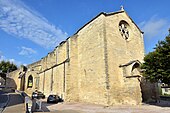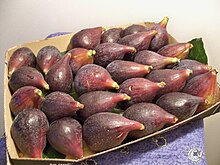Caromb
| Caromb | ||
|---|---|---|

|
|
|
| region | Provence-Alpes-Cote d'Azur | |
| Department | Vaucluse | |
| Arrondissement | Carpentras | |
| Canton | Monteux | |
| Community association | Ventoux-Comtat-Venaissin | |
| Coordinates | 44 ° 7 ' N , 5 ° 6' E | |
| height | 129-453 m | |
| surface | 17.98 km 2 | |
| Residents | 3,348 (January 1, 2017) | |
| Population density | 186 inhabitants / km 2 | |
| Post Code | 84330 | |
| INSEE code | 84030 | |
| Website | http://www.ville-caromb.fr/ | |
 View of Caromb from the Dentelles de Montmirail |
||
Caromb is a French municipality with 3348 inhabitants (at January 1, 2017) in the department of Vaucluse in the region Provence-Alpes-Cote d'Azur .
geography
Caromb is located at the foot of Mont Ventoux , about eight kilometers northeast of the neighboring town of Carpentras . Other neighboring communities are Mazan in the south, Modène in the east, Malaucène and Le Barroux in the north and Saint-Hippolyte-le-Graveyron in the west.
The municipality is traversed in the south by the Mède and one of its tributaries, the Malagrone (east of the village, in a north-south direction). The Brégoux , which also feeds the four hectare man-made Lac du Paty, forms practically the western border .
traffic
In Caromb, several small country roads cross, which connect the village with the surrounding communities. The most important road is the D938 (former RN538 ) from Carpentras towards Malaucène , which runs to the west .
history
Antiquity
At the time of the Kelto-Ligurians , the Memini tribe lived in the region around Carpentras and south of Mont Ventoux , who were neighboring with the Voconti , the Cavars and the Albici .
In the 2nd and 3rd centuries there was a Roman Temple of Apollo on the site of the Saint-Étienne chapel . Archaeologists have unearthed mosaics , firebucks , lamps, Roman medals and a beautiful statue of Apollo here.
middle Ages
Caromb is first mentioned in a document in 1021 as Ad Carumbum , which etymologically means "pile of stones". In Provencal, the similar-sounding Quairoun or queiruon refers to a large square block of stone, which may indicate the operation of quarries in the area. In 1185 the name Carumpio appears for the village , followed by 1254 Carumbo . The Celtic word Car describes a very stony landscape, while Umbo in Latin means a hill or a hill.
An Isabelle de Caromb, daughter of the knight Rican de Caromb, is known as the first liege mistress around 1200. She married the knight Giraud de Vincens, Seigneur von Brantes, Savoillans and Saint Lèger.
In 1240, Raymond VII of Toulouse , Margrave of Provence, gave the Baux fief to Barral . Cécile des Baux, known as Rascasse or "Beautiful Countess", brought it as a dowry to Raymond Guilhem de Budos , Rector of Comtat Venaissin and nephew of Pope Clemens V. Caromb then returned to his first liege-bearers, since Amadeus des Baux, Count of Avellino , bequeathed the fief to his niece Alice des Baux .
Renaissance

In 1431 the fief went by marriage to Astorg de Peyre and the barons of Gévaudan , who also became lords of Beaumes-de-Venise , then to the princes of Orange in 1451. Now it was assigned to Étienne, a bastard from the house Chalons-Orange, who sold it to Étienne de Vaesc for 10,000 thalers , Seneschal of Beaucaire in the service of King Charles VIII. The latter decided to settle permanently and had a castle built between 1481 and 1506, which was reputed to be the Avignon Papal Palace Surpass beauty. He could no longer witness the end of construction, as he died in 1501.
The last heir to this family was Jeanne de Vaesc, who married the Count of Sault , François d'Agoult, in 1553 . On his initiative, the bell tower, the public fountain and the fortification wall were built in 1562. The defense system immediately did its job, as in the same year the Baron des Adrets , after the failed capture of Apt , now besieged Caromb. The fief then returned to Jeanne d'Agoult, who bequeathed it to her second son Charles de Labaume-Montrevel in 1629.
Modern
In 1761 Gaspard de Lascaris, vice delegate of Avignon , granted Caromb town charter . A city council with 24 councilors was elected, headed by two consuls . During the revolution , Marguerite de Labaume-Montrevel, wife of the Marquis de Longeville, had the castle, plundered by the inhabitants, torn down. The remaining ruins and the subsequently parceled land were sold in 1818.
Population development
| year | 1962 | 1968 | 1975 | 1982 | 1990 | 1999 | 2006 | 2017 |
|---|---|---|---|---|---|---|---|---|
| Residents | 1763 | 1901 | 2114 | 2266 | 2640 | 3117 | 3177 | 3348 |
Attractions
- The listed church of St-Maurice dates from the 11th / 12th centuries. Century. It was originally dedicated to Notre-Dame-des-Grâces ("Our Lady of Grace"), then in 1420 to St. Mauritius and his companions. Its Romanesque apse was replaced by a Gothic choir apse with a ribbed vault . Your organ case is Provencal craftsmanship from the 18th century. The tomb of Étienne de Vaesc is located in the Gothic chapelle seigneuriale .
- Remains of the city wall
- The fountain on Place du Château dates back to 1749 and is the work of the royal engineer Antoine d'Allemand , who also built the Carpentras aqueduct and the oil mill at the foot of the belfry
- Belfry from the 16th century with a wrought iron bell cage
- botanical educational trail around the house (17th century) of the Barbérini brothers, nephews of Pope Urban VIII.
- Wine Museum of the Saint-Marc Cooperative
- Community school from the early 20th century
- a dozen small drywall huts on the hill of Paty that were formerly used for agriculture and date back to the mid-19th century.
- The Lac du Paty is a four-hectare lake, which from 1764 to 1766 as storage for irrigation was applied. Today it is a favorite place for fishing and picnicking.
economy
In 1762, the town council decided to dam the Brégoux for irrigation. The work, financed by the city, was carried out according to plans by Jean-Claude Morand, a mathematics professor at the Jesuit College of Avignon. The resulting reservoir, Lac du Paty, has a water volume of 400,000 cubic meters. Thanks to him, olives, fruit, vegetables and wine were grown in the 19th century.
Nowadays, viticulture has become an important economic factor. Caromb is located in the Ventoux (AOC) wine region .
The cultivation of figs is also important , especially a special variety called Ficus carica “ Noire de Caromb ”. The promotion of this variety in the region is promoted by the Confrérie de la Figue Longue Noire de Caromb .
Parish partnership
- Glashütten , Germany, since 1977
literature
- Robert Bailly: Dictionnaire des communes du Vaucluse . A. Barthélemy, Avignon 1986, ISBN 2903044279 .
- Jules Courtet: Dictionnaire géographique, géologique, historique, archéologique et biographique du département du Vaucluse. Christian Lacour, Nîmes 1997, ISBN 284406051X .
- Jean-Pierre Saltarelli: Les Côtes du Ventoux, origines et originalités d'un terroir de la vallée du Rhône. A. Barthélemy, Avignon 2000, ISBN 2879230411 .
Web links
- Official website (French)
- History of Caromb (French)
- Community partnership Caromb-Glashütten
- La Confrérie de la Figue Longue Noire de Caromb (French)
Individual evidence
- ^ Jean Gallian: Les premiers peuples. In: Histoire de Carombe, Tome I. Retrieved June 11, 2013 (French).
- ^ Jean Gallian: Autour de l'an Mil. In: Histoire de Carombe, Tome I. Retrieved June 11, 2013 (French).
- ^ Jean Gallian: Sous les comtes de Toulouse. In: Histoire de Carombe, Tome I. Retrieved June 11, 2013 (French).
- ^ A b Robert Bailly: Dictionnaire des communes du Vaucluse . 1986, p. 127.
- ^ A b c Jules Courtet: Dictionnaire géographique, géologique, historique, archéologique et biographique du département du Vaucluse , 1997, p. 117.
- ^ A b Robert Bailly: Dictionnaire des communes du Vaucluse . 1986, p. 128.
- ↑ a b c d Jean-Pierre Saltarelli: Les Côtes du Ventoux , 2000, p. 117.
- ^ Jules Courtet: Dictionnaire géographique, géologique, historique, archéologique et biographique du département du Vaucluse , 1997, p. 118.
- ↑ Jules Courtet: Dictionnaire géographique, géologique, historique, archéologique et biographique du département du Vaucluse , 1997, p. 116.
- ↑ a b c Michel Albarède et al .: Vaucluse (= Encyclopédies du Voyage ). Gallimard Loisirs, Paris 2007, ISBN 2-7424-1900-4 , p. 312-313 .






